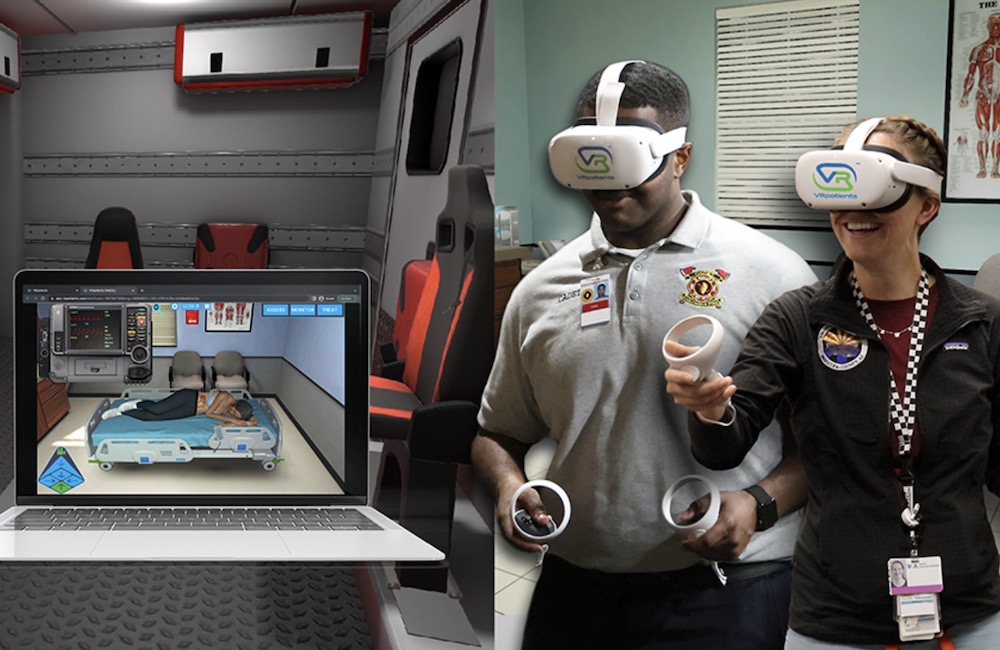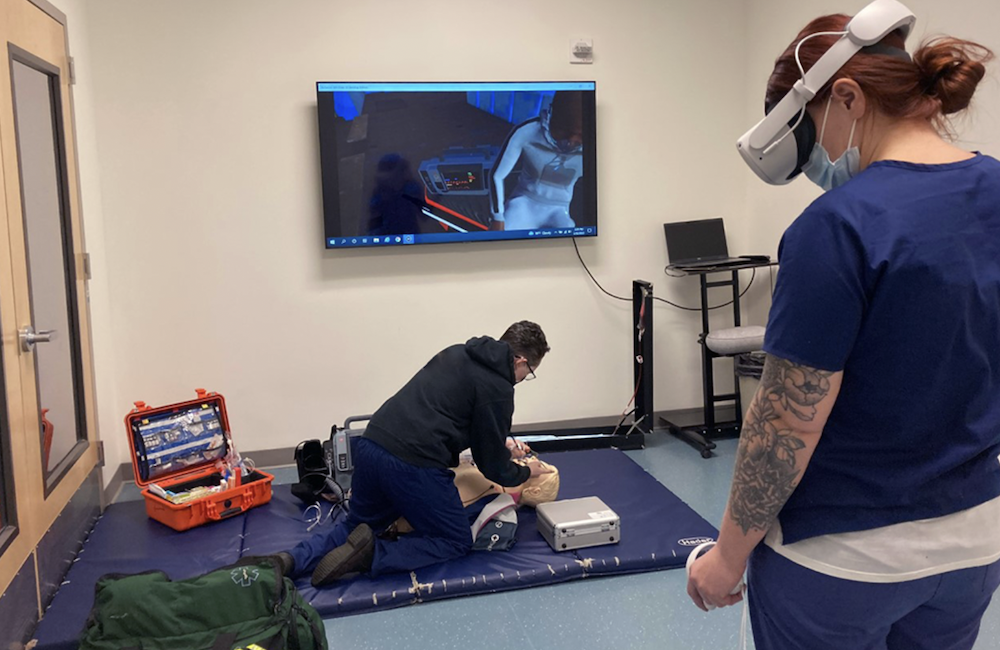VRpatients Allows Nurse Educators to Build Custom Scenarios
Realistic healthcare simulation has proven to have a great impact on preparing practitioners for the field. VR is ideal for reinforcing critical thinking, implementing new protocols, assessing student readiness, and building confidence. Incorporating virtual reality has become simplified over the years as technology and equipment are easier to transport, set up, and put into practice. Earlier this year, VRpatients introduced Nurse Educators to their custom-built healthcare simulation platform which has been helping them begin to think beyond just the practical applications of VR training. This HealthySimulation.com article highlights the importance of helping Nurse Educators and healthcare specialists optimize their simulation scenario implementation.
According to VRpatients, the implementation of such simulation during the initial course curriculum cannot be understated. The company asks readers to contemplate what healthcare education would look like should the conversation around virtual simulation change, and virtual reality be weaved into the curriculum? What if you could make every day a sim day?
Upon posing this question, VRpatients further asks readers to imagine a medical curriculum where healthcare simulation was part of daily learning. To assist in the training of nursing students, VRpatients developed “real-life training without real-life consequences.” The company’s fully customizable clinical case scenarios provide access to limitless learning. Below are two examples of how Nurse Educators can implement virtual reality training to augment traditional classroom training.
Sponsored Content:
VRpatients Healthcare Simulation Scenario 1: New Students
Imagine you are a new nursing student just getting started with your anatomy and physiology lessons. Included in your course fees and books was a VR headset. When you picked everything up from the bookstore you were unsure when you were going to use a VR headset but the excitement was setting in.
After a little while, you begin chapters on cardiology and conduction. The faculty reminds everyone to charge and update their headsets because tomorrow they are going to connect the dots on cardiac conduction with a visualization of a virtual patient with a cardiac problem. The next day, in the middle of lecture, everyone puts on their headsets and each student enters the same scenario with a sick patient. Each student sees the patient in the clinic, activates the cardiac monitor, visualizes the 12-lead ECG, watches the patient clutch their chest, and gets to ask the patient a few assessment questions. They even utilize a stethoscope by listening to heart tones for the first time.
At the conclusion of the day, the faculty instructs the students to continue their studies at home. At any moment they can enter VRpatients to engage with a list of 20 patient scenarios built to follow along with the chapters in their book. Later in the semester, they will be tested on their critical thinking skills and expected to correctly treat each patient to prepare for their credentialing exams, but today, they may fail as often as they want without affecting their grade.
Sponsored Content:
The faculty will see how often students log in, which scenarios they are exploring, and how this new level of engagement is affecting their retention of the chapters from the text. In year one, students are engaging in an exploratory, non-destructive patient care environment, preparing them for competency and the real-world implementation of the “Novice to Nurse Expert Model.”
Never before has this level of student engagement been possible. Never before has a faculty had the power to develop their own virtual reality patient scenarios in a no-code simulation building tool. Never before has simulation been so easy for a single faculty to engage an entire class at once and weave clinical simulation throughout the curriculum. The students are no longer “wowed” by the fact that they are using VR.
Instead, VR becomes as comfortable as reviewing notes on a notepad; the technology fades into the background and suddenly success benchmarks are easily surpassed as this new technology increases efficiency and comprehension for an entire cohort of qualified new graduate nurses. Hospitals from all over are now eager to hire the next batch of highly competent students because on the first day their critical thinking skills are equivalent to RNs with one or two years of experience.
VRpatients Healthcare Simulation Scenario 2: Expert Faculty
Imagine students in their final year of school are preparing for clinical rotations and luckily, their Nurse Educator has over 20 years of experience and still works in the hospital every week. On lecture day, seasoned faculty often bring them relevant and recent stories from the frontlines. This is to prepare students for the critical thinking of patient care and to teach them how to navigate the high acuity, low-frequency patients; including the tough ones that don’t always survive.
Today is a different type of lecture day. Students are all instructed to arrive at class with their headsets fully charged and updated. Recently, their seasoned faculty had a very difficult patient who didn’t survive. The faculty member documented the case and created a patient scenario in virtual reality using the VRpatients no-code sim builder tool.
Now, the students will each get the opportunity to save the life of that exact same patient and debrief with their instructor. Never before has an individual faculty member been empowered to train a cohort of students with relevant and realistic patient experiences in virtual reality. This new level of higher education pushes the boundaries of how a “novice” becomes an “expert” nurse. Only through repetition, hands-on critical thinking, and expert guidance from faculty can a student be ready to provide safe patient care.
Virtual reality patient simulations with VRpatients simply accelerates the “Aha!” moment for learners; giving them the confidence they need to enter the workforce and become truly ready for patient care.
More About VRpatients
VRpatients is a physiologically based clinical training platform that immerses a healthcare provider or first responder into actual clinical case scenarios, allowing them to assess, diagnose and treat patients in real-time. Available through a web-based platform or through a full clinical simulation experience using a virtual reality headset such as the Oculus, Pico, or HTC Vive headsets.
VRpatients allows healthcare practitioners to test and expand their clinical skills, reducing the likelihood of critical performance failure. Additionally, VRpatients for nursing takes the risk out of real-life training by implementing repeatable, lifelike virtual simulations with responsive patient avatars that react in real-time. VRpatients allows the Nursing Educator to objectively assess the clinical judgment of nurses to ensure their clinical competency and train quickly on new or existing protocols with its error-proof case logic. Subscription-based options are flexible, based on the organization’s needs.
Learn More About VRpatients Nursing Solutions
Lance Baily, BA, EMT-B, is the Founder / CEO of HealthySimulation.com, which he started in 2010 while serving as the Director of the Nevada System of Higher Education’s Clinical Simulation Center of Las Vegas. Lance also founded SimGHOSTS.org, the world’s only non-profit organization dedicated to supporting professionals operating healthcare simulation technologies. His co-edited Book: “Comprehensive Healthcare Simulation: Operations, Technology, and Innovative Practice” is cited as a key source for professional certification in the industry. Lance’s background also includes serving as a Simulation Technology Specialist for the LA Community College District, EMS fire fighting, Hollywood movie production, rescue diving, and global travel. He and his wife live with their two brilliant daughters and one crazy dachshund in Las Vegas, Nevada.
Sponsored Content:



















